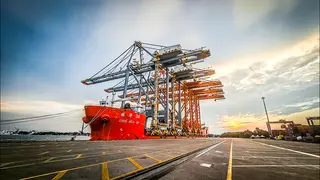Work on India’s first high-speed bullet train, which promises to speed up travel between Ahmedabad and Mumbai at 320 km per hour, is proceeding at a matching furious pace. The ₹25,000-crore allocation in the interim Budget 2024-25 — one of the highest ever in recent years — is yet another sign of the importance the central government accords to the project, which is expected to launch services between Ahmedabad (Gandhi Ashram station) and Mumbai (Bandra-Kurla Complex station) around 2026-27.
The proposed budgetary outlay is 35 per cent higher than the revised estimates of FY24 at around ₹18,600 crore. The budget estimates for FY24 was ₹19,600-odd crore with support from internal and extra-budgetary resources at ₹20,592 crore.
In FY23, the National High-Speed Rail Corporation Limited (NHSRCL) — a special-purpose vehicle created for the project by the railway ministry, which holds 50 per cent equity, and the state governments of Gujarat and Maharashtra, which hold 25 per cent equity each — had budgetary support of ₹12,000 crore.
The foundation stone for the Mumbai-Ahmedabad high-speed rail project was laid in September 2017 by Prime Minister Narendra Modi and his Japanese counterpart Shinzo Abe.
On January 24 this year, Railways Minister Ashwini Vaishnaw posted on X (formerly Twitter) that land acquisition for the bullet train project was “100 per cent complete”, and 274.12 km of pier casting and 127.72 km of girder launching had been completed.
Also read
Cost break-up
The initial estimate for the project cost was ₹1.08 lakh crore
The 508-km high-speed rail corridor will traverse about 350 km in Gujarat and 156 km in Maharashtra.
In November 2023, it was announced that NHSRCL had completed 100 km of viaduct and 250 km of pier work.
A soft loan extended by Japan International Cooperation Agency (JICA) will help fund 81 per cent of the construction cost, with the rest coming through NHSRCL.
Until December 2023, the status of equity contribution for the project showed approval for ₹20,000 crore, which includes ₹10,000 crore from the railway ministry and ₹5,000 crore each from the Gujarat and Maharashtra governments. While the ministry and the Gujarat government have paid their share in full, Maharashtra has paid only ₹6 crore till date.
Progress report
The December report on the progress of the bullet train project, accessed by businessline, shows that work in the Maharashtra section was completed to the tune of 22.03 per cent, while it was 47.44 per cent in Gujarat. So the overall completion stands at 39.12 per cent.
The report mentions completion of land acquisition in Gujarat, Dadra and Nagar Haveli, and Maharashtra. Nearly 81 per cent of the acquired land in Maharashtra is under the possession of the SPV, it adds.
According to railway officials, all the 11 civil tender packages across Gujarat and Maharashtra have been awarded.
“The issue of Master Implementation Plan was discussed and the Japanese side indicated that phased commissioning in Gujarat (Vapi-Sabarmati section) in Aug 2027, as a common target between Japan and India, could be considered...” the report says.
Financially the progress stands at 44.36 per cent, a senior railway official said, requesting anonymity. Of the approximately ₹54,000 crore raised so far, ₹11,400-odd crore is the extent of capital utilisation during the current fiscal (FY24). Spending during December 2023 was to the tune of ₹1,173 crore, according to the report.
Vaishnaw had earlier said that political differences with the erstwhile Uddhav Thackeray government in Maharashtra had delayed work on the bullet train project, including land acquisition, floating of tenders, award of contracts and so on. “There is substantial progress in the segment now,” he said recently.
Japanese concerns
According to the project’s progress report, the Japanese side has, in October 2023, initiated price negotiations with a sole bidder for the electrical works. The deadlines for operationalising various sections of the project include Surat-Bilimoria by July 2026 and Sagarmati-Vapi by August 2027.
The detailed design for signalling and telecom (S&T) has been completed by the Japanese side. It has decided to place early orders for long-lead S&T equipment such as automatic train control, electronic interlocking, track circuits, point machine accessories, cab radio, and so on for the 12 stations on the route.
“For these early orders, five separate packages are planned and contracts would be awarded directly to OEMs [original equipment manufacturers], as per the Japanese practices. Award of these contracts is expected by Feb 2024,” the report mentions.










Comments
Comments have to be in English, and in full sentences. They cannot be abusive or personal. Please abide by our community guidelines for posting your comments.
We have migrated to a new commenting platform. If you are already a registered user of TheHindu Businessline and logged in, you may continue to engage with our articles. If you do not have an account please register and login to post comments. Users can access their older comments by logging into their accounts on Vuukle.